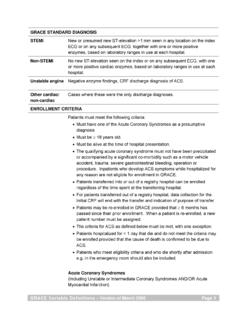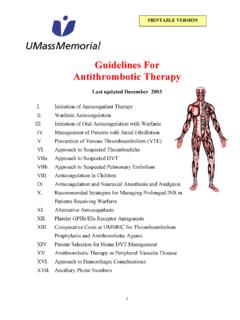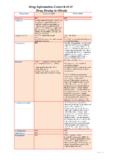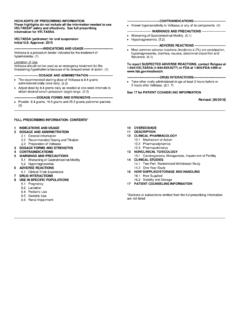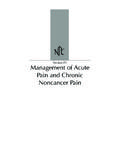Transcription of Guidelines For Antithrombotic Therapy - Welcome …
1 PRINTABLE VERSION. Guidelines For Antithrombotic Therapy Last updated December 2003. I. Initiation of Anticoagulant Therapy II. Warfarin Anticoagulation III. Initiation of Oral Anticoagulation with Warfarin IV. Management of patients with Atrial Fibrillation V. Prevention of Venous Thromboembolism (VTE). VI. Approach to Suspected Thrombophilia VIIa. Approach to Suspected DVT. VIIb. Approach to Suspected Pulmonary Embolism VIII. Anticoagulation in Children IX Anticoagulation and Neuraxial Anesthesia and Analgesia X. Recommended Strategies for Managing Prolonged INR in patients Receiving Warfarin XI. Alternative Anticoagulants XII. Platelet GPIIb/IIIa Receptor Antagonists XIII. Comparative Costs at UMMHC for Thromboembolism Prophylaxis and Antithrombotic Agents XIV. Patient Selection for Home DVT Management XV. Antithrombotic Therapy in Peripheral Vascular Disease XVI. Approach to Hemorrhagic Complications XVII. Ancillary Phone Numbers 1. Developed by the Antithrombotic Therapy Task Force Eric Alper, Frederick Anderson, Richard C.
2 Becker, , (Chair). Doreen Brettler, Stephen Erban, James Froehlich, Pritesh Gandhi, Barbara Maas, Liberto Pechet, Michael J. Rohrer, Frederick A. Spencer, Maichi Tran, Acknowledgments: Richard Irwin, and Nicholas Smyrnios, The Guidelines for Antithrombotic Therapy in adults and children were developed by an experienced group of clinicians through careful review of current literature and consensus statements from recognized experts in the field. Our objective is to optimize the management of patients at risk for and those with thromboembolic disorders of the venous and arterial circulatory systems through evidence-based laboratory testing, drug selection and treatment strategies. These Guidelines and subsequent updates are posted on the UMass Memorial Intranet under Clinical Practice Guidelines . 2. I. INITIATION OF ANTICOAGULANT Therapy . A. Fractionated, Low Molecular Weight Heparin (LMWH) (SC Administration). Lovenox 1 mg/kg (maximum dose 150 mg) every 12h (unstable angina, non-ST elevation MI).
3 Lovenox 1 mg/kg (maximum dose 150 mg) every 12h (venous thromboembolism). (outpatient or inpatient Rx). Lovenox mg/kg (maximum dose 225 mg) qd (venous thromboembolism) (inpatient Rx). Lovenox 1 mg/kg (maximum dose 120 mg) every 12h (ST elevation MI Rx with TNK- tPA)*. LMWH does not prolong aPTT; minimal prolongation of ACT may be observed. Routine coagulation monitoring is not required; however, an anti-Xa level may be useful in the following situations: bleeding complications, extremes of body weight (<50 kg, >150 kg), renal insufficiency (creatinine clearance <40 ml/min)*, pregnancy, acute burns, and recurrent thrombosis despite drug treatment. dosing adjustments and anti-Xa monitoring may be required in these patients , therefore, consider consulting Anticoagulation Service. During treatment the peak anti-Xa level (not to exceed Units/ml) is determined 4 hours after the 3rd dose. The trough level (> Units/ml) is determined before the 4th dose. The test is performed in the UMass-Memorial laboratory.
4 * Rx may be initiated with Lovenox 30 mg IV bolus. Dose modifications are required with creatinine clearance < 40 ml/min and experience is limited. Contact Anticoagulation Service for recommendations. B. Unfractionated Heparin (IV Administration). Initial bolus 60 Units/kg (not to exceed 5000 Units; 4000 Units MAX with tPA and related fibrinolytics). Initial infusion Dose Initial MAX rate Low intensity ( ACS) 15 Units/kg/hr 1200 units/hr and tPA or GPIIb/IIIa receptor antagonist 12 Units/kg/hr 1000 units/hr High Intensity 18 Units/kg/hr 1800 units/hr ( Acute Venous Thromboembolism). Target aPTT 50-70 sec for acute coronary syndromes (including concomitant tPA or platelet GPIIb/IIIa antagonist Therapy ). Target aPTT 60-85 sec for venous thromboembolism. If 2 consecutive aPTT values are < 50 sec or > 90 sec, notify MD. If infusion rate reaches or exceeds 2200 units/hour (44cc/hr), call MD. C. Candidates for Anticoagulant Therapy Obtain baseline aPTT, PT (INR), CBC with platelet count.
5 Screen for contraindications; assess bleeding risk. Heme test stool. 3. Check platelet count every 3 to 5 days during Therapy (daily if decrease is observed) to evaluate for possible heparin-induced thrombocytopenia (HIT). Unfractionated Heparin- dosing Nomogram For Adult patients Requiring Lower Intensity Anticoagulation ( Acute Coronary Syndromes). aPTT Repeat Bolus* Stop Infusion Rate Change Repeat aPTT 2,+. (Sec) (Units) (min) (Units/h) (h). <35 Repeat bolus 0 +150 (3cc/hr) 4. 35-49 Half bolus 0 +100 (2cc/hr) 6. 50-70 0 0 No change 6 hours x 1;. then q 7 am 71-90 0 0 - 100 (2cc/hr) 6. 91-120 0 0 - 150 (3cc/hr) 4. 121-150 0 0 - 200 (4cc/hr), call HO 4. >150 0 Y HOLD, call HO 4. * maximum dose for repeat bolus 3000 Units (avoid repeat bolus dosing with fibrinolytic Rx). ~ aPTT should be checked every 4-6 h until target achieved, then at least daily. + a PTT should be checked every 4-6 h for at least 24 h after tPA and related fibrinolytics. Unfractionated Heparin dosing Nomogram For patients Requiring Higher Intensity Anticoagulation ( Acute Venous Thromboembolism).
6 APTT Repeat Bolus Stop Infusion Rate Change Repeat aPTT 2,+. (Sec) (Units) (min) (Units/h) (h). <35 Repeat initial bolus 0 +200 (4cc/hr) 4. 35-59 Half initial bolus 0 +150 (3cc/hr) 6. 60-85 0 0 No change Next AM. 86-100 0 0 - 100 (2cc/hr) 6. 101-120 0 0 - 150 (3cc/hr) 4. 121-150 0 0 - 200 (4cc/hr), call HO 4. >150 0 Y HOLD, call HO 4. Aspirin (81 to 162 mg qd) or clopidogrel (75 mg qd) can be used as an adjunct to warfarin in high-risk patients ; however, the risk of bleeding is increased with combination Therapy . D. Non-Acute Indications for Unfractionated Heparin Unfractionated heparin may be used as bridging anticoagulation in hospitalized patients with chronic conditions requiring temporary discontinuation of warfarin. Such conditions include: Chronic A-fib, cardiomyopathy/LV aneurysm Prosthetic heart valves Prior DVT/PE. Prior arterial embolic events Such patients rarely require rapid achievement of therapeutic PTTs and often have increased bleeding risks (as they are hospitalized).
7 Therefore consider: 4. Using the nomogram for lower intensity anticoagulation Avoiding or decreasing boluses of unfractionated heparin Check PTTs no more frequently than q 6 h E. patients with Increased Bleeding Risk On occasion, patients with increased bleeding risk will require unfractionated heparin (AVMS/prior GI bleed, recent stroke, recent surgery, etc.) For these patients , consider: Individualized dosing (do not use nomogram). Avoiding or decreasing boluses of unfractionated heparin Slow titration upward to target PTT. Daily assessment for signs/symptoms of bleeding, daily CBC. Anticoagulation Services consult II. WARFARIN ANTICOAGULATION. Indication Target INR Range Prophylaxis of venous thrombosis (high-risk patients ) (2-3). Treatment of venous thrombosis (after heparin) (2-3). Treatment of pulmonary embolism (after heparin) (2-3). Prevention of systemic embolism* (2-3). Bioprosthetic heart valves (particularly in the first 3 months) (2-3). Atrial fibrillation (2-3).
8 Recurrent systemic embolism 3 ( ). Mechanical prosthetic valves ** 3 ( ). Post-myocardial infarction (secondary prevention) ** 3 ( ). Antiphospholipid antibody syndrome (with prior thrombosis) ( ). Long-term indwelling catheters (prophylaxis) warfarin 1 mg daily * Aspirin (81 to 162 mg PO qd) or clopidogrel (75 mg PO qd) can be used as an adjunct to warfarin in high-risk patients ; however, the risk of bleeding is increased with combination Therapy . ** A target INR of (range ) is acceptable for bileaflet mechanical values (eg. St. Jude Valve) in the aortic position. ** A target INR of (range ) plus aspirin (81 mg) is also acceptable. III. INITIATION OF ORAL ANTICOAGULATION WITH WARFARIN. The dosing of warfarin must be individualized according to patient need and anticoagulant response as reflected by the INR. Large initial doses (>10 mg for several days). increase the risk of hemorrhage and other complications, do not offer more rapid protection against thrombotic events, and are not recommended.
9 Lower doses (less than 5 mg) are recommended among elderly and/or debilitated patients , following mechanical heart valve surgery and when sensitivity (increased anticoagulant response) to warfarin is anticipated. interactions on page 7). 5. Step-Wise Approach DAY 1: Obtain Baseline INR. Begin Therapy with warfarin at a dose of 5 mg (or less) per day with dosage adjustments based on serial INR determinations. For patients on Heparin (unfractionated or low molecular weight): Because the anticoagulant effect of warfarin is delayed, heparin is administered for rapid anticoagulation. When clinically indicated, conversion to warfarin should begin concomitantly with initiation of heparin Therapy . After an overlap of three to five days, heparin can be discontinued when a therapeutic INR has been documented on two consecutive days. DAY 2: Check INR Daily. Adjust Warfarin Dose Based on Serial INR. Determinations. patients Stabilized in the Target Range: Intervals between subsequent INR determinations should be based upon patient reliability, concomitant medications, and response to warfarin.
10 Acceptable intervals for INR determinations are normally one to four weeks after a stable dosage has been determined. In general, the INR should be checked within 1 to 3 days of hospital discharge. Most patients are satisfactorily maintained on to 5 mg warfarin daily; however, the requirements vary widely. Reminder * Be aware of potential drug interactions, medical illnesses and other factors (diet) that may affect the INR and /or warfarin response, particularly after hospital discharge. * Patient education is an important part of Therapy . Safe and effective treatment is most often achieved among cooperative and well-instructed patients who communicate with their health care team. Drug Interactions with Warfarin Numerous factors, including travel, changes in diet, environment, physical state and medications may influence a patient's response to warfarin Therapy . It is considered good practice to monitor the patient's response with additional INR determinations in the period immediately after hospital discharge, and when other medications are initiated, discontinued or taken irregularly.
